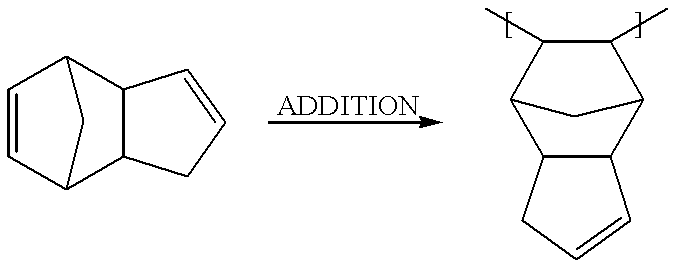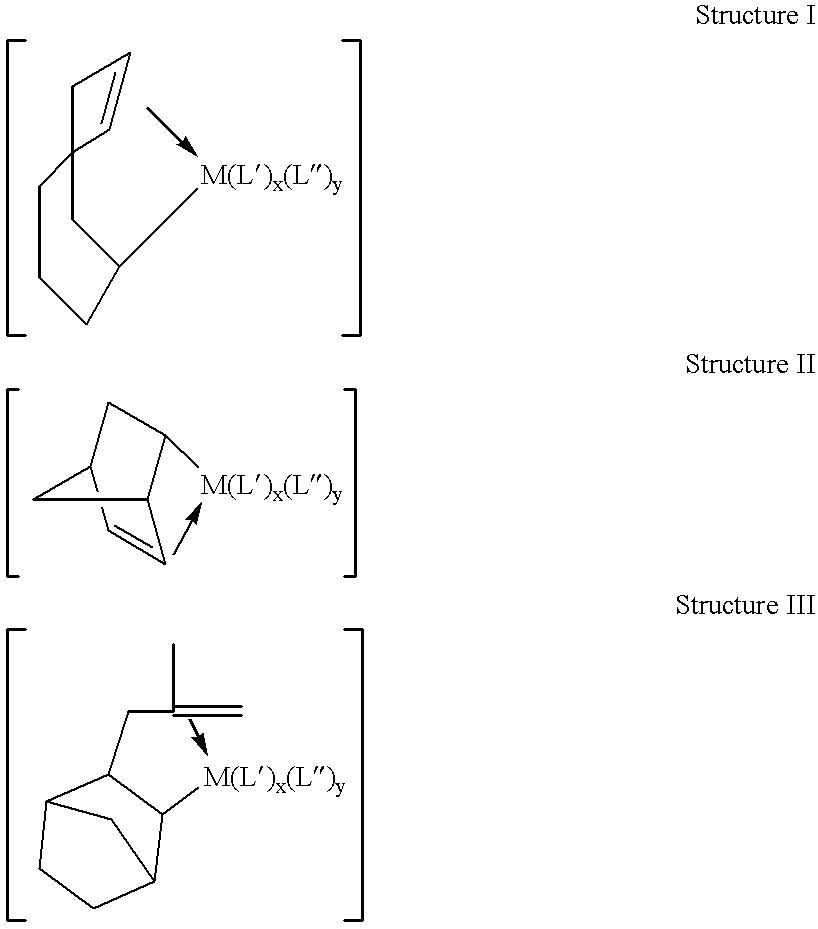Mold addition polymerization of norbornene-type monomers using group 10 metal complexes
a metal complex and monomerization technology, applied in the direction of coatings, etc., can solve the problems of poor thermal stability, difficult melting process of polymers once formed, and retained monomer unsaturated nature of starting monomers in the polymer backbone, etc., to achieve the effect of convenient displacemen
- Summary
- Abstract
- Description
- Claims
- Application Information
AI Technical Summary
Benefits of technology
Problems solved by technology
Method used
Image
Examples
example 1
A two-component polymerization system was prepared giving a reactant ratio of monomer:procatalyst:activator=10,000:1:2. Component A: LiWCA-H (9.4 mg) was dissolved in 1.0 g methylnorbornene. Component B: 5.0 mg (allyl)Pd(O.sub.2 CCF.sub.3)PCy.sub.3 was dissolved in 9.0 g methylnorbornene. A and B components were injected into a high-pressure reactor at 55.degree. C., and the pressure raised to 900 psi. After 10 min. a solid object was removed from the reactor. Yield by TGA=83.4%.
example 2
A two-component polymerization system was prepared giving a reactant ratio of monomer:procatalyst:activator=10,000:1:2. Component A: LiFABA (9.8 mg) was dissolved in 0.71 g triethoxysilylnorbornene. Component B: 3.0 mg (allyl)Pd(O.sub.2 CCF.sub.3)PCy.sub.3 was dissolved in 9.5 g hexylnorbornene. A and B components were mixed at 60.degree. C. A solid object was obtained. Yield by TGA=96.0%.
example 3
A two-component polymerization system was prepared giving a reactant ratio of monomer:procatalyst:activator=10,000:1:2. Component A: LiFABA (9.8 mg) was dissolved in 0.71 g triethoxysilylnorbornene and 0.50 g hexylnorbornene. Component B: 3.3 mg (allyl)Pd(O.sub.3 SCF.sub.3)PCy.sub.3 was dissolved in 9.0 g hexylnorbornene. A and B components were mixed at 55.degree. C., and the following reaction parameters describe the reaction: t.sub.gel =40 s, t.sub.100.degree. C. =50 s, t.sub.200.degree. C. =55 s, t.sub.Tmax =110 s, t.sub.gel =85.degree. C., t.sub.Tmax =257.degree. C. A solid object was obtained. Yield by TGA=96.4%.
PUM
| Property | Measurement | Unit |
|---|---|---|
| temperature | aaaaa | aaaaa |
| Tg | aaaaa | aaaaa |
| Tg | aaaaa | aaaaa |
Abstract
Description
Claims
Application Information
 Login to View More
Login to View More - R&D
- Intellectual Property
- Life Sciences
- Materials
- Tech Scout
- Unparalleled Data Quality
- Higher Quality Content
- 60% Fewer Hallucinations
Browse by: Latest US Patents, China's latest patents, Technical Efficacy Thesaurus, Application Domain, Technology Topic, Popular Technical Reports.
© 2025 PatSnap. All rights reserved.Legal|Privacy policy|Modern Slavery Act Transparency Statement|Sitemap|About US| Contact US: help@patsnap.com



